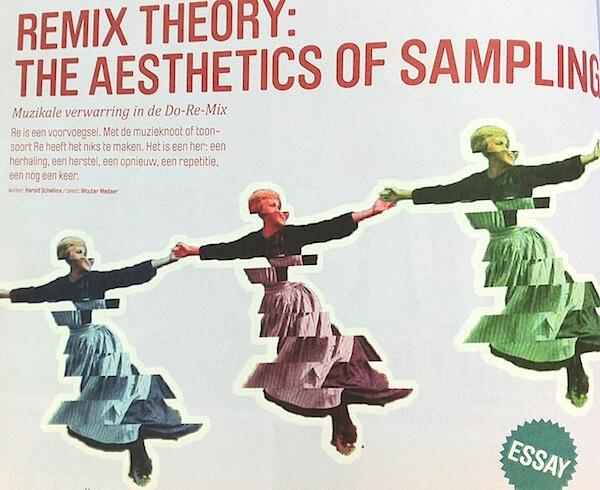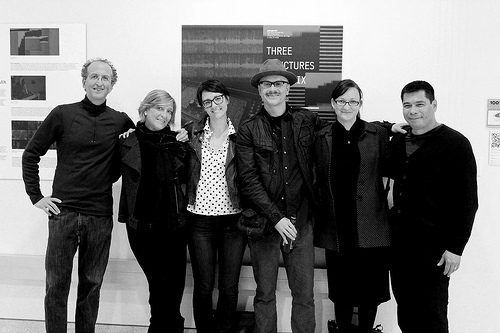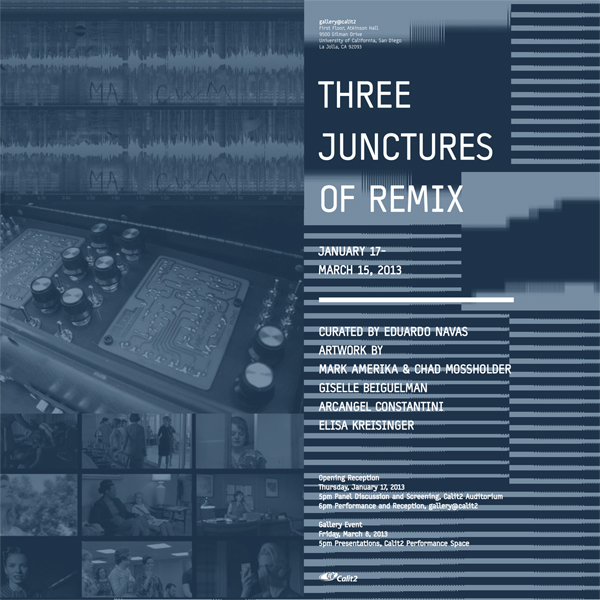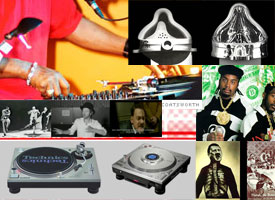Hip-Hop to Dubstep: International Music Styles and the Remix, Part 3 of 7
Above: The Amen Break documentary by Nate Harrison, included in the resource selections below.
List of online resources and music selection for week 3 of Hip-Hop to Dubstep, taught during the summer of 2013 at The New School’s Media Studies, Department of Communication. I will be releasing brief notes based on my class lectures in the near future. If interested in looking at the actual class webpage with all the weekly selections at once, feel free to peruse this link: http://navasse.net/NS/NCOM3039A/. My notes will not be available on the class webpage, only on each corresponding entry here on Remix Theory. Please note that links may become broken. If and when this happens, the best thing to do is to search for the source by name. And do let me know if anything is broken and I will look into it.
View:
Part 1
Part 2
Week 3
June 17 – 21, 2013
Dub/Disco/Hip-Hop
Music selection and relevant links:
The Joy of Disco – The Joy of Disco:
http://www.youtube.com/watch?v=4zQpMnU6N4o
Amen Break Documentary (by Nate Harrison):
http://www.youtube.com/watch?v=5SaFTm2bcac
The Winstons – Amen Brother:
http://www.youtube.com/watch?v=GxZuq57_bYM
Scratch
http://www.youtube.com/watch?v=bj1r6u8zLPo&feature=player_embedded
TB-303 Documentary – Bassline Baseline (2005)
http://www.youtube.com/watch?v=TLQwwtjtiY4
The hip hop years part 1:
http://www.youtube.com/watch?v=LhrSlOa2bsA
The hip hop years part 2:
http://www.youtube.com/watch?v=9Qjs771lWnE
The hip hop years part 3:
http://www.youtube.com/watch?v=E_46ig2V74I
Copyright Criminals
http://www.youtube.com/watch?v=tIoR3PYpduo
Music Selection from Jamaica, Dancehall:
Yellowman – King Yellowman (Full Album) 1984
http://www.youtube.com/watch?v=i11zpqkmupg
Yellowman Reggae Sunsplash 1982
http://www.youtube.com/watch?v=Ko46_aXW_94
Mr Loverman- Shabba Ranks
http://www.youtube.com/watch?v=tcWif3u4A0A
House Call (Your Body Can’t LieTo Me), featuring Maxi Priest
http://www.youtube.com/watch?v=IwtAGWWC9y4
Elephant Man – Willie Bounce
http://www.youtube.com/watch?v=r038-tDd8eI
Elephant Man & Wyclef Jean – FIVE-O
http://www.youtube.com/watch?v=0nNiBgS4bZ0
YouTube Selection of Dancehall:
http://www.youtube.com/watch?v=wH_0_
pijbZY&list=RD02IwtAGWWC9y4
Music Selection from UK, Northern Soul:
Frank Wilson – “Do I Love You” (Arguably once the rarest record ever)
http://www.youtube.com/watch?v=xwvpeYiQwss
The O’Jays – I Love Music (1975)
http://www.youtube.com/watch?v=e_1s2UFc_z8
R Dean Taylor – There’s A Ghost In My House
http://www.youtube.com/watch?v=cp62EBeSZUc
Love On A Mountain Top – Robert Knight
http://www.youtube.com/watch?v=96eiVUoWzB8
Bobby Freeman – “C’mon And Swim”
http://www.youtube.com/watch?v=1l2agUPZ7lc
The four tops – I can’t help myself – Live HQ
http://www.youtube.com/watch?v=qXavZYeXEc0
Gloria Jones – “Tainted Love” (1964)
http://www.youtube.com/watch?v=LKUjI_CbIY0
(Not northen soul, but a cover of “Tainted Love,” 1984 sequential mashup with “Where did our Love Go?” by Soft Cell, New Wave version):
http://www.youtube.com/watch?v=srtuQU20QXA
Music Selection from U.S., Disco (before mid-seventies, soul music influenced by the Motown sound):
Viva Tirado Live – El Chicano (1970) 1971 performance:
http://www.youtube.com/watch?v=vxmwPkqkCnk
(See Kid Frost below under rap for a sample used in a rap song)
Charles Wright & The Watts 103rd Street Rhythm Band “Love Land” (1970)
http://www.youtube.com/watch?v=sZ0yX05h3IQ
The Friends of Distinction – “Love or Let Me Be Lonely” (1970)
http://www.youtube.com/watch?v=hnEbZjOhUQU
Manu Dibango – “Soul Makossa” (1973)
http://www.youtube.com/watch?v=w2jYjUiulMQ
Kook and the Gang – “Jungle Boogie” (1974)
http://www.youtube.com/watch?v=QHGOO73Gxg4
MFSB TSOP The Sound Of Philadelphia (1974)
http://www.youtube.com/watch?v=-3nPLfG9gZY
Van McCoy – “The Hustle” (1975)
http://www.youtube.com/watch?v=wj23_nDFSfE
Sylvester – You Make Me Feel (mighty real)
http://www.youtube.com/watch?v=oG2ixYJ79iE
James Brown – The Original Disco Man DISCO (1979)
http://www.youtube.com/watch?v=OHQJDbeT1lM
Village People – “In the Navy”
http://www.youtube.com/watch?v=InBXu-iY7cw
Village People – “Just a gigolo”
http://www.youtube.com/watch?v=1FvVcagZln0
Donna Summer ” Love To Love You Baby ”
http://www.youtube.com/watch?v=X6iTciIqLxM
Donna Summer I Feel Love [Extended Dance Edit] (1977)
http://www.youtube.com/watch?v=ljxm3NsnVI0
Donna Summer – I Feel Love (Patrick Cowley Megamix)
http://www.youtube.com/watch?v=Q1km3Fbeo0w
Le Freak – Chic (1978)
http://www.youtube.com/watch?v=DbzooE7jtiE
“Le Freak (House/Funk Deep Remix)”
http://www.youtube.com/watch?v=v9e1REw6WFY
Chic Megamix – in memory of Bernard Edwards (mixed in the tradition of the old days with two turntables)
http://www.youtube.com/watch?v=AMlhtKw_Sds
More, More More – Andrea True Connection
http://www.youtube.com/watch?v=RlJGrIyt-X8
Bee Gees – “Staying Alive” (1979)
http://www.youtube.com/watch?v=I_izvAbhExY
Bee Gees Megamix (Straight on two turntables, as it would be done at the club)
http://www.youtube.com/watch?v=dxZckhvwsoM
Music Selection from U.S. (Electro-funk/techno-funk, or simply… “funk” as it was called and known to DJs playing it.)
Three key tracks that informed funk in the eighties:
Babe Ruth’s “The Mexican,” James Brown’s “The Payback”, and The Incredible Bongo Band’s “Apache”
“The Mexican” (break played by Mancuso and DJs in the Bronx, happens at 3:35 – 445)
http://www.youtube.com/watch?v=_YhRkAF1tXM
Incredible Bongo Band – “Apache” (1973)
http://www.youtube.com/watch?v=vnsc_U4sJ8Q
“Apache” is actually a cover originally recorded by The Shadows in 1969:
http://www.youtube.com/watch?v=NoN6AKPGkBo
James Brown, “The Payback” (1973)
http://www.youtube.com/watch?v=IST6qRfVqwY
James Brown’s drummer, Clyde Stubblefield is arguably the most sampled drummer in history:
http://www.youtube.com/watch?v=OOS18vi7WLc
Unity by James Brown & Afrika Bambaataa
http://www.youtube.com/watch?v=b6hE5OmpKyc
Afrika Bambaataa and the Soul Soinc Force -“Planet Rock”
(extended mix, 1982)
http://www.youtube.com/watch?v=7XPmOpLVZPI
Afrika Bambaataa, “Looking for the Perfect Beat”
http://www.youtube.com/watch?v=2RJlYzBhLg4
Twilight 22 – “Electric Kingdom”
http://www.youtube.com/watch?v=2RJlYzBhLg4
Al Naafiysh “The Soul” Side A:
http://www.youtube.com/watch?v=zbvDORZ0HlU
Side B:
http://www.youtube.com/watch?v=i46sF1PcqL8
It’s about time Remix:
http://www.youtube.com/watch?v=8hLUjEO2ZCs
Cybotron “Clear”
http://www.youtube.com/watch?v=fGqiBFqWCTU
“Clear” Frankie Bones (founder of House music) Remix:
http://www.youtube.com/watch?v=kkrk5Gzo_2A
Herbie Hancock, “Rock it”
http://www.youtube.com/watch?v=GHhD4PD75zY
Live version (inspired many DJs including Mix Master Mike to become DJs–becaue of Grandmaster DSTs performance)
http://www.youtube.com/watch?v=TN5ltss0NMA
See Mike Scratching:
http://www.youtube.com/watch?v=0DLED7krHwU
Much of early electro-funk borrowed (sampled freely) or were heavily influenced by the music of Kraftwerk (Germany). Two songs that were heavily sampled are:
Kraftwerk – “Numbers”
http://www.youtube.com/watch?v=4YPiCeLwh5o
Kraftwerk – “Transeurope Express”
http://www.youtube.com/watch?v=qBGNlTPgQII
Newcleus was clearly influenced by the sound coming out of Germany. “Push the Button makes this quite evident.” Also note that while Newcleus were very much experimenting with electro-funk, they also would rap, as you will notice one of their most successful songs is included under the rap section below.
Newcleus – “Push the Button” (extended mix) (1983)
http://www.youtube.com/watch?v=67zWw4UfHWE
Newcleus – “Push the Button” (with vocal intro)
http://www.youtube.com/watch?v=Vatk9sF7qyI
The P Crew – “Nasty Rock” (1983)
http://www.youtube.com/watch?v=Y5rbZ-RQbIg
Midnight Star – “Freakazoid” (1983)
http://www.youtube.com/watch?v=uRo426va26I
Music Selection from U.S., Hip Hop (Rap):
Grand Master Flash and the Furious Five – “The Message” (1982)
http://www.youtube.com/watch?v=O4o8TeqKhgY
The Egyptian Lover “Egypt Egypt” (1983)
http://www.youtube.com/watch?v=qjFs9CPGhts
The Egyptian Lover “I Need a Freak” (1983)
http://www.youtube.com/watch?v=o4Cd9wGHtr0
Newcleus – “Jam on It” (1984)
http://www.youtube.com/watch?v=zEmg5GaAHbk
Whodini – “Friends” (1984)
http://www.youtube.com/watch?v=tECCvdWEweA
Whodini – “Five Minutes of Funk”
http://www.youtube.com/watch?v=pskKw8sPtQk
Whodini – “Five Minutes of Funk” (Instrumental)
http://www.youtube.com/watch?v=_Y5pj1IoJ7Q
Ice T – “Reckless” (1984)
http://www.youtube.com/watch?v=POydN8X1GSY
Ice T – “Reckless” (extended mix)
http://www.youtube.com/watch?v=CdnPn8QTDIU
Dr. Dre and the Wrecking Crew (1984)
http://www.youtube.com/watch?v=RT9O-pUGsVM
World Famous Supreme Team (1984)
http://www.youtube.com/watch?v=FHMVkqCKknc
Malcolm Mclaren, “World Famous” (1984)
http://www.youtube.com/watch?v=Dq_dDiLZl38
Malcom Maclaren, “Hobo Scratch” (1984)
http://www.youtube.com/watch?v=B_mHENbpmHk
UTFO – “Roxanne Roxanne”
http://www.youtube.com/watch?v=4KpngczmD7Q
Roxanne Shante “Roxanne’s Revenge”
http://www.youtube.com/watch?v=zVy2LHKFG18
Run DMC – King of Rock (1985)
http://www.youtube.com/watch?v=qXzWlPL_TKw
Run DMC – Sucker MCs (1984)
http://www.youtube.com/watch?v=rXVFNs0piP8
Beastie Boys – License to Ill (1986)
http://www.youtube.com/watch?v=U7M7d8u40I4&list=PL07ABD2EB68C1C470
NWA, “Something 2 dance 2” (1988)
http://www.youtube.com/watch?v=794JyvaTHqQ
NWA, “Straight Out of Compton” (1988)
http://www.youtube.com/watch?v=-MrQtOoQRpc
Public Enemy – “Don’t Believe the Hype” (1988)
http://www.youtube.com/watch?v=9vQaVIoEjOM
Public Enemy – “Fight the Power” (1990)
http://www.youtube.com/watch?v=8PaoLy7PHwk
Queen Latiffah and Monie Love – “Ladies First” (1989)
http://www.youtube.com/watch?v=hLB5bUNAesc
Monie Love “Monie in the Middle” (1990)
http://www.youtube.com/watch?v=AxHLYjz_oEs
Kid Frost – La Raza (1990)
http://www.youtube.com/watch?v=bZ8AS300WH4
(See disco section for the original song “Viva Tirado” by El Chicano to hear the source of melody and percussion samples)
Music Selection from U.S., Hip Hop (Turntablism):
Grandmaster Flash, Adventures on the Wheels of Steel
http://www.youtube.com/watch?v=gXNzMVLqIHg
Grandmaster Flash Ibiza 2010
http://www.youtube.com/watch?v=nwvkRx0eV68
Grandmaster Flash live, 2011
http://www.youtube.com/watch?v=ue2BVDCF9Vg
DJ Shadow, “Midnight in a Perfect World”
http://www.youtube.com/watch?v=nmzHRGoKca0
DJ Crush, Kemuri
http://www.youtube.com/watch?v=aVjgRlto8PI
Invisible Skratch Picklz Live
http://www.youtube.com/watch?v=GQ3N6XADe9I
DJ Qbert, 2012 DMC
http://www.youtube.com/watch?v=SS0rl7IGHwA
DJ Qbert & Mix Master Mike 2012 DMC
http://www.youtube.com/watch?v=h7pVbJClzuc
Kid Koala (Jazz improvization, date unknown)
http://www.youtube.com/watch?v=KbFIGFv4GLQ
Beat Junkies 1998
http://www.youtube.com/watch?v=29TIvv5uIVE















